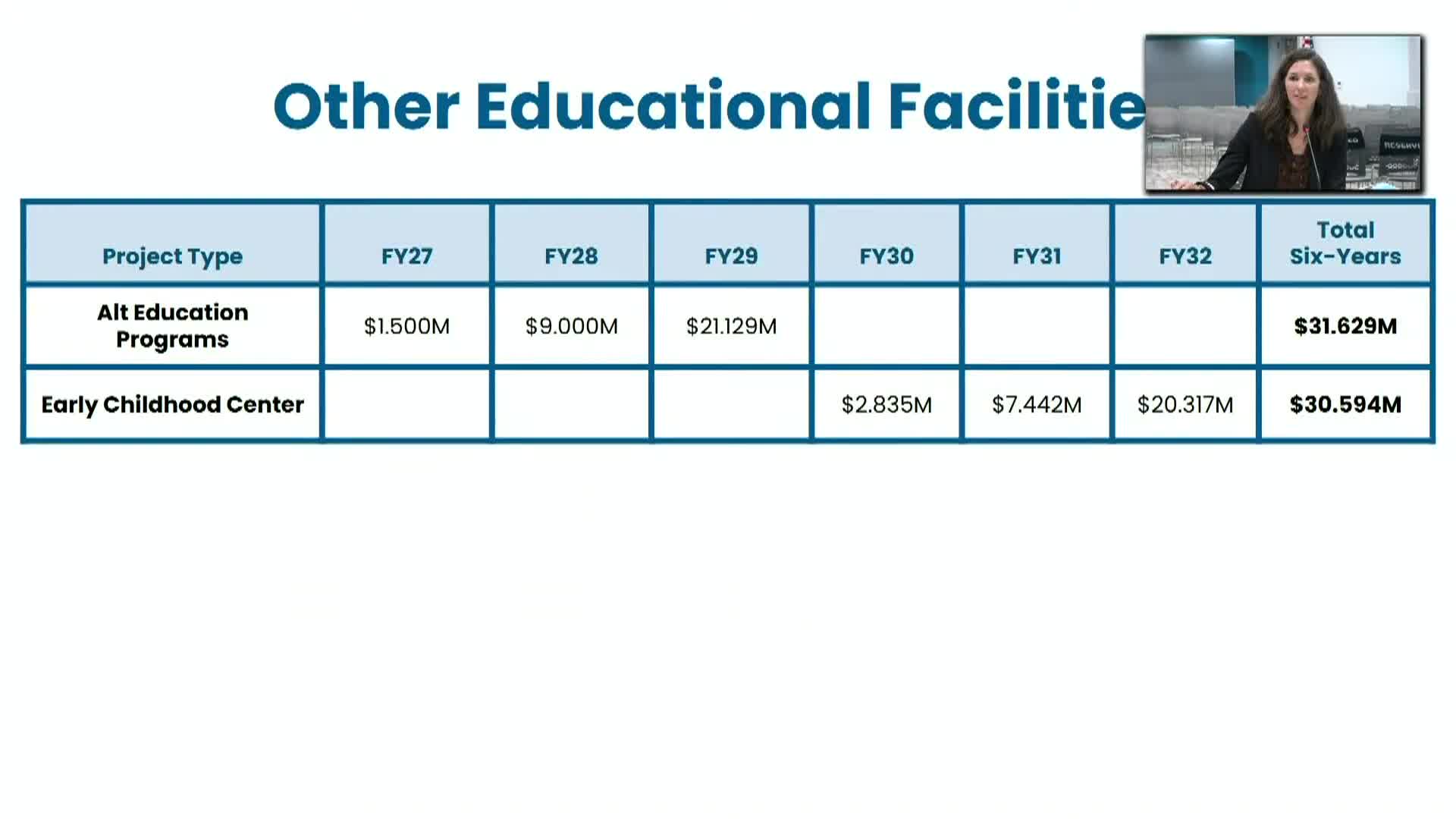MCPS proposes permanent space for alternative education and expands early childhood capacity in CIP
October 15, 2025 | Montgomery County Public Schools, School Boards, Maryland
This article was created by AI summarizing key points discussed. AI makes mistakes, so for full details and context, please refer to the video of the full meeting. Please report any errors so we can fix them. Report an error »

Montgomery County Public Schools staff told the board on Oct. 14 that the superintendent’s FY27 CIP recommendation includes new investment to provide permanent, improved facilities for alternative‑education programs and to expand the district’s early‑childhood capacity.
Alternative education
Staff said the district has historically operated alternative‑education programs in aging, repurposed office buildings and that the CIP proposal moves to provide a permanent, purpose‑built campus for programs now colocated at multiple temporary sites.
DJ Connolly described the change this way: “these students were not provided the opportunity to have a gymnasium and certain other features that our pre k to 12 students have access to every single day.” The presentation said consolidation and a permanent facility would allow alternative students access to more of the same instructional and extracurricular infrastructure found in the rest of the district.
The presentation outlined a multi‑year plan to consolidate existing sites (the Germantown/Cloverleaf and Silver Spring locations) into a permanent location at the Avery Road/Avery site (Blair Ewing/Mark Twain campus) and to scope design/construction funding in the FY27–FY32 window.
Early childhood
Staff described a regional and mixed‑delivery model that uses both existing early‑childhood centers and space at elementary campuses to expand pre‑K seats. Key numbers presented:
- By FY2032 the district said it plans to serve about 4,500 income‑eligible full‑day 4‑year‑olds (tier 1 and tier 2), requiring an additional 79 classrooms.
- The district also plans to serve about 2,300 pre‑K students receiving special education services, which staff said would require roughly 116 additional classrooms (smaller class sizes for those services).
Staff flagged several facility moves and staging plans: a new Burtonsville early‑childhood center (using the existing Burtonsville site as early‑childhood center #3), continued use of a temporary Northlake Center site for one year, and plans to use Emery Grove and Spring Mill centers as part of the staging and permanent strategy.
Board questions and staff response
Board members said stability for alternative‑education students and the staff who serve them is a major concern; several asked how many times programs would be moved and whether temporary moves could be minimized. Staff said the recommendation aims to create a permanent home and that the sooner the district secures a permanent site, the fewer disruptive moves will be required.
Ending
Staff said early‑childhood expansion and alternative‑education consolidation are part of a broader shift away from capacity‑only projects and toward investments that address programmatic facilities. Detailed design and funding choices will return to the board during the second CIP work session and in future CIP cycles.
Alternative education
Staff said the district has historically operated alternative‑education programs in aging, repurposed office buildings and that the CIP proposal moves to provide a permanent, purpose‑built campus for programs now colocated at multiple temporary sites.
DJ Connolly described the change this way: “these students were not provided the opportunity to have a gymnasium and certain other features that our pre k to 12 students have access to every single day.” The presentation said consolidation and a permanent facility would allow alternative students access to more of the same instructional and extracurricular infrastructure found in the rest of the district.
The presentation outlined a multi‑year plan to consolidate existing sites (the Germantown/Cloverleaf and Silver Spring locations) into a permanent location at the Avery Road/Avery site (Blair Ewing/Mark Twain campus) and to scope design/construction funding in the FY27–FY32 window.
Early childhood
Staff described a regional and mixed‑delivery model that uses both existing early‑childhood centers and space at elementary campuses to expand pre‑K seats. Key numbers presented:
- By FY2032 the district said it plans to serve about 4,500 income‑eligible full‑day 4‑year‑olds (tier 1 and tier 2), requiring an additional 79 classrooms.
- The district also plans to serve about 2,300 pre‑K students receiving special education services, which staff said would require roughly 116 additional classrooms (smaller class sizes for those services).
Staff flagged several facility moves and staging plans: a new Burtonsville early‑childhood center (using the existing Burtonsville site as early‑childhood center #3), continued use of a temporary Northlake Center site for one year, and plans to use Emery Grove and Spring Mill centers as part of the staging and permanent strategy.
Board questions and staff response
Board members said stability for alternative‑education students and the staff who serve them is a major concern; several asked how many times programs would be moved and whether temporary moves could be minimized. Staff said the recommendation aims to create a permanent home and that the sooner the district secures a permanent site, the fewer disruptive moves will be required.
Ending
Staff said early‑childhood expansion and alternative‑education consolidation are part of a broader shift away from capacity‑only projects and toward investments that address programmatic facilities. Detailed design and funding choices will return to the board during the second CIP work session and in future CIP cycles.
View full meeting
This article is based on a recent meeting—watch the full video and explore the complete transcript for deeper insights into the discussion.
View full meeting
